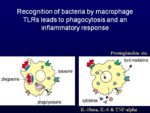Innate Immunity to Bacteria
The innate response to bacterial infection lies in its first-response role of detection of a foreign organism. By using the tools of Pattern-Recognition Receptors (PRRs), the innate response flags up problems while the adaptive response gets itself organized.
Once a foreign organism is detected, the innate system responds by engaging in cell warfare via phagocytosis and triggering the inflammatory response. The release of inflammatory cytokines will cause an increase in vasodilation, vascular permeability and an influx of white blood cells. Neutrophils take on their primary role as phagocytes in this phase. In addition, systemic effects of inflammatory cytokines will sustain a rise in core temperature (fever), the release of acute phase proteins from the liver, and bone marrow mobilization as the need for white blood cells production is increased. Acute phase proteins will bind to bacterial cell walls, enhancing neutrophil, macrophage, and complement-initiated phagocytosis.
Also see Immunity to Bacteria
| This article has been expert reviewed by Dr Robert J Francis BSc(Hons) PhD Date reviewed: May 10, 2012 |
| Originally funded by the RVC Jim Bee Award 2007 |
